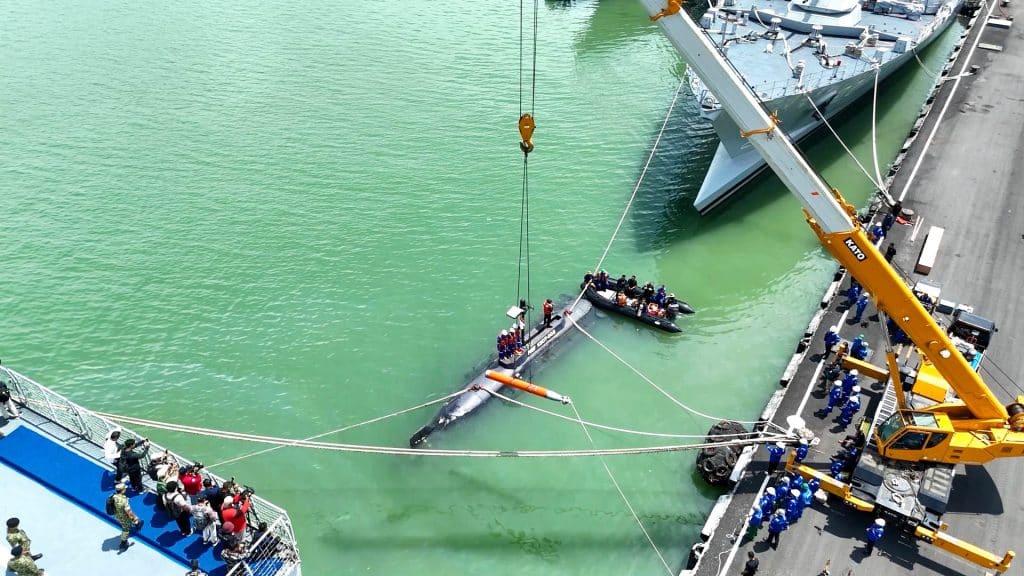Indonesia has entered a new phase in undersea warfare. PT PAL and the Indonesian Navy (TNI‑AL) conducted a live torpedo launch from the KSOT autonomous submarine in Surabaya. The firing followed KSOT’s public debut at the Armed Forces’ 80th anniversary parade on 5 October. As a result, Jakarta now signals intent to field weapon‑capable uncrewed submarines and broaden deterrence across critical straits.
Key Facts
Event: Live firing of a lightweight torpedo from surfaced KSOT at TNI‑AL 2nd Fleet Command, Surabaya.
Platform: KSOT prototype — approx. 15 m length, 2.2 m beam, ~37.3 t displacement; cruise 5 kt / max 8 kt; ~90 nm/18 h endurance; test depth ~50 m (prototype).
Roadmap: Target variant aims at up to six months (6,000 nm) endurance and 350 m diving depth.
Regional context: Australia’s Ghost Shark XLAUV rolls off the line in Sydney as the Royal Australian Navy scales uncrewed undersea capability.
Why the KSOT Autonomous Submarine Matters
For Southeast Asia, a live torpedo release from an uncrewed submarine marks a threshold. It shows a shift from experimental UUVs to weapon‑capable autonomous submarines. Three points stand out. First, the firing validates weapon handling, basic fire‑control logic, and hull behaviour at launch. Second, it forces work on rules of engagement and command‑and‑control (C2) with autonomy in the loop. Third, it pushes regional navies to fund counter‑UUV sensing, hard‑kill and soft‑kill tools, and seabed asset protection.
Indonesia’s needs are unique. The country must defend thousands of islands and several trade straits. Consequently, a network of small, affordable and persistent autonomous submarines could complicate an adversary’s plans. It could also free manned boats to focus on high‑end tasks. In that sense, the KSOT autonomous submarine is a doctrinal trial in scalable undersea mass, not a one‑off prototype.
What We Know About KSOT So Far
PT PAL lists the prototype at 15 m length, 2.2 m beam and about 37.3 t displacement. The boat cruises at 5 kt and can reach 8 kt. Endurance is roughly 90 nm over 18 hours. During the Surabaya event, crews loaded a single lightweight torpedo while the vehicle was on the surface. They then launched it from the same condition. Public imagery shows a compact external tube and a conservative firing profile. This is consistent with a first live test.
Looking ahead, PT PAL targets endurance of up to six months, or roughly 6,000 nm, and a maximum depth near 350 m for a later variant. Reaching those goals will require gains in energy storage and power management. It will also need reliable navigation in denied waters. Additionally, the design must support robust long‑range communications for intermittent or covert data bursts.
Weapon‑capable autonomy at sea is less about a single test and more about the full stack: power, sensing, navigation, comms resilience, and tightly governed C2.
Defence Agenda analysis
Regional Trendline: Australia’s Ghost Shark Enters Production
Meanwhile, Australia has opened a 7,400 m² facility in Sydney to produce the Ghost Shark extra‑large autonomous undersea vehicle (XLAUV) for the Royal Australian Navy. The program, budgeted at about A$1.7 billion, has rolled the first vehicle off the line ahead of schedule. Sea‑acceptance testing is planned, with deliveries from early 2026. The concept is clear: generate distributed, affordable and scalable undersea mass. It can be forward‑deployed, moved by air or sea and teamed with crewed submarines and surface combatants.
By contrast, Australia appears to optimise for long‑range ISR (intelligence, surveillance, reconnaissance) and strike with deep‑persistence XLAUVs. Meanwhile, Indonesia is trialling a smaller uncrewed submarine for littoral defence, strait control and point‑defence strike. In the end, both paths converge on manned–unmanned teaming and a denser undersea sensor‑shooter web across the Indo‑Pacific.
Technical Focus: Power, Autonomy and Communications
Power & endurance. Extending endurance from hours to months pushes KSOT toward hybrid energy architectures. Options include high‑specific‑energy primary cells, fuel cells or AIP‑like (air‑independent propulsion) approaches. Crucially, thermal and acoustic management must remain tight. The KSOT autonomous submarine must also reserve power for sensors, navigation aids and secure communications.
Autonomy stack. Weapon release in autonomous systems should stay bounded by human‑on‑the‑loop governance. Practically, that requires clear mission profiles, structured abort logic, geofencing and positive control checks. In complex littorals—heavy traffic, low depths and variable salinity—robust perception and navigation are decisive.
Communications & C2. Salt water is unkind to radio waves. Therefore, KSOT will rely on an acoustic backbone with periodic mast breaks or buoy relays for satellite uplinks. The architecture should assume degraded comms and use autonomy to execute intent‑based tasks between sparse control windows.
Operational Implications for Southeast Asia
The ability to field many small, semi‑autonomous shooters shifts undersea cost‑exchange ratios. Even a modest production run could raise surveillance and defensive burdens for competitors. As a result, Indonesia gains options below the threshold of escalation. In peacetime, KSOT autonomous submarines can watch key straits. In crisis, they can complicate access and threaten high‑value units or seabed assets.
For neighbours, the likely response includes more seabed sensors, passive acoustic arrays and counter‑UUV tactics. In addition, policy work will be needed: notification practices, deconfliction in busy waterways and alignment with emerging norms on autonomous weapons at sea.
What To Watch Next
First, watch for repeat firings from submerged states and any move beyond a single round. Second, track progress toward long endurance for the KSOT autonomous submarine, including safe battery chemistries, energy‑dense stacks and reliable long‑range comms. Third, note procurement signals—industrialisation plans, unit costs and any international collaboration that enables scale.
Related Analysis
Advances in USV Tech: Tomorrow’s Hybrid Fleet — How uncrewed surface vessels are reshaping maritime force design and teaming concepts. (Internal)
References
- [1] Asian Military Review, “Indonesia launches torpedo from an autonomous submarine prototype (KSOT).”
- [2] Reuters, “Anduril opens Australian factory to build undersea ‘Ghost Shark’ drones,” and “Australia to spend $1.1 billion on Anduril undersea drone fleet.”
- [3] Naval News, “Indonesia conducts first torpedo test from KSOT autonomous submarine.”
- [4] Janes OSINT Insight, “Indonesia fires torpedo from autonomous submarine.”
- [5] ABC News Australia, “Plans for $1.7 billion underwater ‘Ghost Shark’ drone fleet.”
- [6] Anduril Australia release, “Ghost Shark Factory Opens in Sydney — First Vehicle Off the Line Ahead of Schedule.”
- [7] ANTARA News, “Indonesian Navy prepares first live‑fire test of unmanned submarine.”
Further Reading
External: Reuters — Ghost Shark factory opens in Sydney; Naval News — KSOT torpedo test coverage; Janes — Indonesia fires torpedo from autonomous submarine; Anduril — Ghost Shark factory release.
Internal: Defence Agenda — Advances in USV Tech: Tomorrow’s Hybrid Fleet








